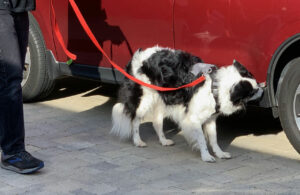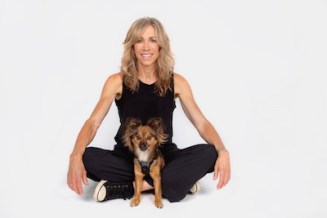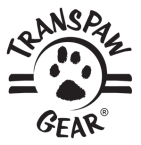Barks Blog
The Right Dog Harness for the Job
By Joan Hunter Mayer of PPG corporate partner Transpaw Gear®

What do selecting a harness for your dog and shoe shopping have in common? More than you might think!
When you venture out- or online- to purchase a pair of shoes, or an outfit, it generally boils down to selecting the right option to fit the person and the activity. For instance, a snazzy pair of stilettos might be great for an evening out, but would they be a good choice for running a marathon, strolling on the beach, or accomplishing everyday tasks?
Similarly, harness selection for dogs depends on the intended activity/activities, body size and shape, how they move, and what’s comfortable and practical – not breed, weight or gender. So, how can dog guardians go about selecting the right harness(es) for the job(s) at hand?
Comfort
First, go by what your dog feels comfortable in, as evidenced by how they respond to your requests to move in various ways. You know your dog’s body language. Even when dogs are encouraged to love their harnesses with lots of positive associations, be vigilant for signs of poor fit.
Is your pup walking sideways? Plopping on the ground? Is her face scrunched up? Is she looking up at you for help, as if something isn’t quite right?
A properly fitted harness should be form fitting enough not to restrict movement in any way. Certainly, it should not cut into the dog anywhere, but also not fit so loosely that it chafes with repetitive movement. And, it should be comfortable enough to wear all day and feel like a second skin – but not like Spanx, a wet suit or a girdle!
Practical
Then there are other practical considerations. Future you will thank you for selecting a harness that is water-friendly and easy to wash and wipe clean.
As previously mentioned, comfort is essential, but so is security. If your dog puts his head through the harness to put it on, there’s a chance he can pull his head out the same way without much warning, which can leave you standing there holding a leash and harness while your dog is taking off! That said, gear should still be easy for you to put on, take off and adjust for a comfortable, secure fit.
Activity
Finally, consider what activity or activities your pup will be doing and what those activities entail. Will you and your dog be going for a relaxing stroll, or on a sniffari, both of you taking your time? Or will your canine pal be walking, running – or skateboarding – next to you at a specific pace? Or all of the above, depending on the day?
You might choose a harness with a back leash attachment or front leash attachment (or option for either one) and/or a harness that has a strong handle for when you need to keep your dog close.
Keep in mind, it’s okay to have more than one harness for your dog. For instance, you might choose to have different harnesses for different activities, where the harness becomes a trigger for that activity, signaling to the dog that it’s time to track, play or walk calmly.
Consider also the following:
-
- For walks, some dogs benefit from having one harness for loose leash walking and a different one associated with high intensity work or play.
- For K9 Nose Work® or tracking, dogs are on leash and it doesn’t matter as much if they pull; you want them to have freedom to move and go where they want to go. They are in control. Here, it would make more sense to clip the leash to the back of the harness because in a Nose Work event, you don’t want to stifle that enthusiasm.
- For outdoor adventures on-leash, it might simply make more sense to use a harness rather than attaching the leash to a collar around the neck. Even a flat collar. Even if your dog is bomb proof and you are the most force-free person in the world. Collars are like wallets – meant to carry ID and match your outfit, that’s it.
- In canine sports like Flyball, where handlers hold on to the dogs before letting them have their turn on the course, you might see handlers amp up the dogs and get them excited, then unclip the leash and let them go.
- When it comes to mobility support, some harnesses have two handles, which can be used for walking support and even for lifting a dog, say into and out of a car. (A single handle can also add support for climbing into or out of cars, just be sure not to lift a dog by the harness unless it’s designed specifically for that.)
- In physical therapy exercises, you can hold the handle on your dog’s harness to help guide him. When dogs know they are supported, they can be more confident in new or challenging situations.
- Canine fitness classes are another example of when you want to ensure freedom of movement and also be able to hold onto the handle of a dog’s harness to offer gentle support.
- Therapy dogs and service dogs may have specialized harnesses specific to their jobs.
- Similarly, search and rescue dogs can wear a special harness and know that then and there it’s okay to pull.
- On the other hand, for times when you prefer your dog walks calmly on a loose leash, using a front leash attachment option can help discourage pulling without usually being aversive. While it can be nice to have multiple options for the location of leash attachment, in any case, the harness is used as a management tool, rather than a training tool.
- A harness can also help you grab your dog quickly in an emergent situation. Because dogs will be dogs. And we will love and protect them.
Let’s face it, in reality, if dogs had it their way, they’d likely be running around naked, without collars or harnesses. But in our human world, it’s our responsibility to protect them, which includes a wardrobe that is comfortable, practical, and yes, even stylish.
So no matter your need for one (or two), here’s to unleashing adventures and harnessing fun… and shoe shopping – if that’s your thing!

Listen to our BARKS Podcast with Joan Hunter Mayer of Transpaw Gear®
Related Posts
- Empowering Dogs and Humans to Have a Deeper, More Connected Relationship – One Harness at a Time
- How to Choose a Harness for Your Dog
- Dog Training in “3D”: Harnessing the Concepts of Distance, Duration and Distractions
About TransPaw Gear®
 TransPaw Gear® remains a small but mighty operation built on transparency and compassion. Most importantly though, we are always keeping an eye on the mission of bringing dogs and humans together. For instance, walking and adventuring are beneficial to the dog-human bond. So, I am hoping that this product will encourage people to unleash adventures and harness fun, from the dog’s point of view. With the combination of quality force-free equipment and excellent training skills, more people can confidently explore dog-friendly places in their towns and neighborhoods and participate in activities that are mutually enjoyable and relationship-enhancing. Here’s to all of you who are harnessing the power and beauty of the dog-human bond!
TransPaw Gear® remains a small but mighty operation built on transparency and compassion. Most importantly though, we are always keeping an eye on the mission of bringing dogs and humans together. For instance, walking and adventuring are beneficial to the dog-human bond. So, I am hoping that this product will encourage people to unleash adventures and harness fun, from the dog’s point of view. With the combination of quality force-free equipment and excellent training skills, more people can confidently explore dog-friendly places in their towns and neighborhoods and participate in activities that are mutually enjoyable and relationship-enhancing. Here’s to all of you who are harnessing the power and beauty of the dog-human bond!
